Audio Performance
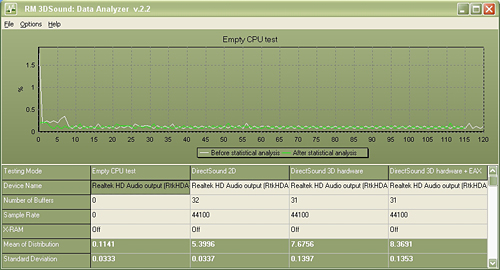
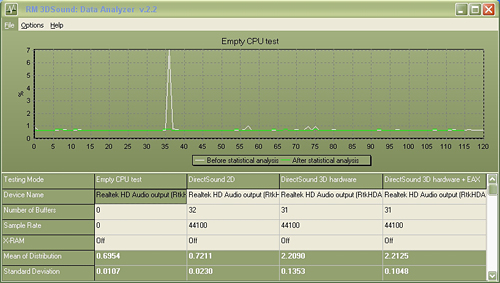
We limited audio testing to the Rightmark 3D Sound version 2.2 CPU utilization test and tested with sound enabled to show the performance effects on several games. The Rightmark 3D Sound benchmark measures the overhead or CPU utilization required by a codec or hardware audio chip.
The Realtek ALC-882D HD audio codec was tested with the recently released 1.34 driver set. The Realtek DirectSound audio drivers do not support more than 32 hardware buffers and the OpenAL 1.1 drivers do not support more than 30 hardware buffers at this time, so the scores cannot be directly compared to the Creative Labs Sound Blaster X-FI cards in the benchmarks.
We ran this benchmark with the standard test platform AMD Athlon64 4000+ CPU and also our AMD Opteron 170 dual-core CPU. It is interesting to note the reduced CPU utilization with the Opteron 170 as the load is balanced between each processor with the Realtek 1.34 drivers. We will be investigating if the reduction in CPU utilization rates with the dual-core setup has any bearing on actual game benchmarks in the near future.
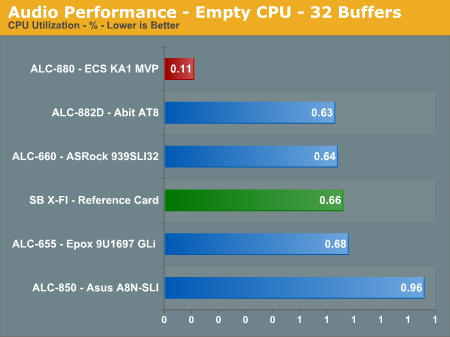
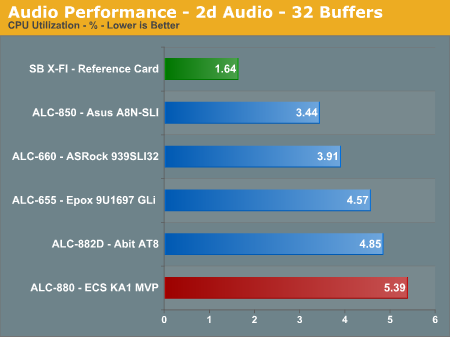
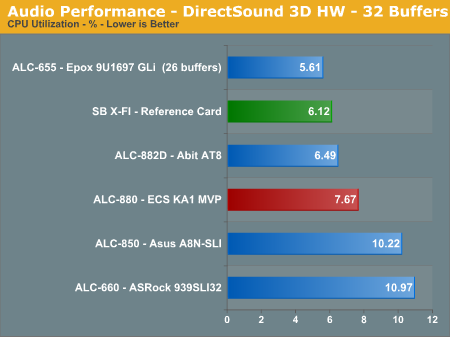
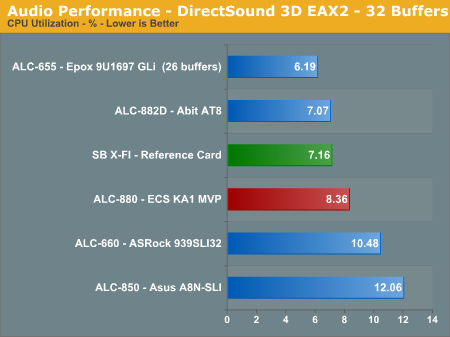
The Realtek ALC-880 codec offers competitive CPU utilization rates when compared to the Realtek ALC-882, ALC-660, and ALC-850 codecs. The ALC-880 generates significantly better audio quality than the ALC-850 based systems and very similar audio quality to the ALC-882 solutions. The ALC-880 was released before the ALC-882 but has nearly the same audio quality and performance. In our subjective headphone testing we noticed a slight difference between the two codecs, with the output from the ALC-882 sounding clearer in the treble and mid-range tones. However, the difference was negligible when utilizing our 4, 5.1, or 7.1 speaker setup in a typical room environment. The Sound Blaster X-FI has the lowest overall CPU usage with the ALC-882 and the ALC-880 following closely. Let's find out how these results translate into real world numbers.
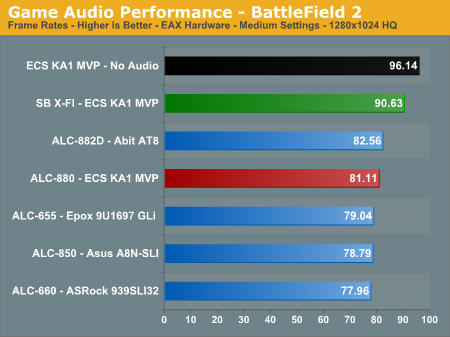
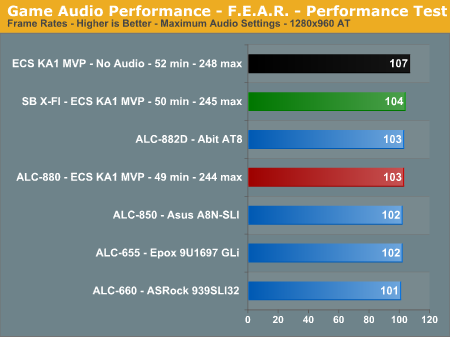
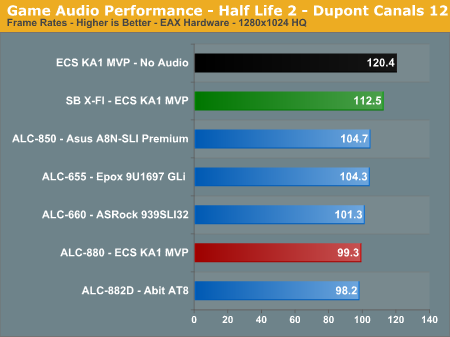
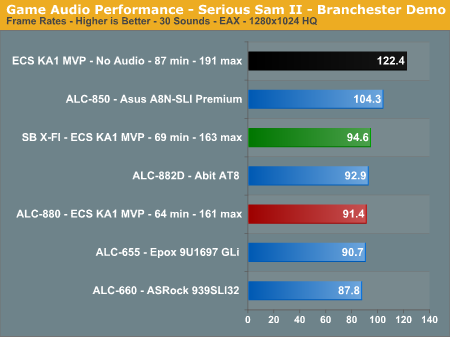
The audio performance numbers remain consistent as the Realtek ALC-880 finishes near the SoundBlaster X-FI benchmarks. Serious Sam II has an average loss of 39%, Battlefield 2 at 18%, Half Life 2 at 21%, and F.E.A.R. at 4%.
The output quality of audio with the Realtek ALC-880 ranks with the ALC-882/883 series as the best of the on-board HD audio solutions we have heard, and performance continues to improve with each driver release. The vast majority of users should have no issues utilizing the ALC-880 as their primary audio solution considering quality of audio and performance at this time in most applications.
Obviously, if you are a serious gamer, then a dedicated sound card is still useful to ensure consistent frame rate averages across a wide variety of games, and in the case of the Sound Blaster X-FI you also get improved audio quality and EAX3/4/5 support. If you'd like more details on the Realtek solution, you can refer to the ALC-880 audio specifications.
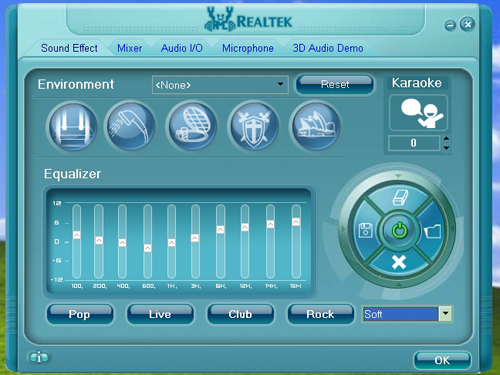
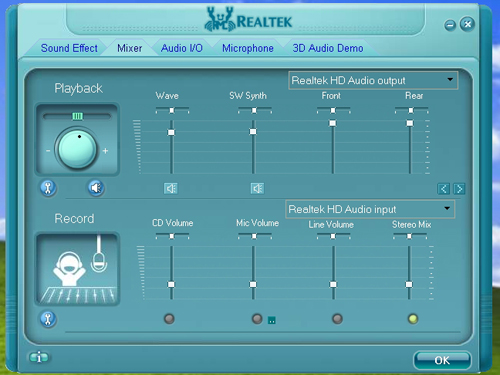
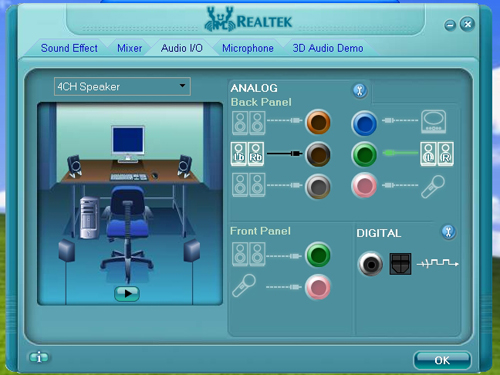
The Realtek 1.34 HD driver installation installs a basic control panel that features a built in 10-band equalizer along with the standard mixer and speaker controls. We found the control panel to be user friendly and a definite improvement over the standard windows audio properties application.


We limited audio testing to the Rightmark 3D Sound version 2.2 CPU utilization test and tested with sound enabled to show the performance effects on several games. The Rightmark 3D Sound benchmark measures the overhead or CPU utilization required by a codec or hardware audio chip.
The Realtek ALC-882D HD audio codec was tested with the recently released 1.34 driver set. The Realtek DirectSound audio drivers do not support more than 32 hardware buffers and the OpenAL 1.1 drivers do not support more than 30 hardware buffers at this time, so the scores cannot be directly compared to the Creative Labs Sound Blaster X-FI cards in the benchmarks.
We ran this benchmark with the standard test platform AMD Athlon64 4000+ CPU and also our AMD Opteron 170 dual-core CPU. It is interesting to note the reduced CPU utilization with the Opteron 170 as the load is balanced between each processor with the Realtek 1.34 drivers. We will be investigating if the reduction in CPU utilization rates with the dual-core setup has any bearing on actual game benchmarks in the near future.




The Realtek ALC-880 codec offers competitive CPU utilization rates when compared to the Realtek ALC-882, ALC-660, and ALC-850 codecs. The ALC-880 generates significantly better audio quality than the ALC-850 based systems and very similar audio quality to the ALC-882 solutions. The ALC-880 was released before the ALC-882 but has nearly the same audio quality and performance. In our subjective headphone testing we noticed a slight difference between the two codecs, with the output from the ALC-882 sounding clearer in the treble and mid-range tones. However, the difference was negligible when utilizing our 4, 5.1, or 7.1 speaker setup in a typical room environment. The Sound Blaster X-FI has the lowest overall CPU usage with the ALC-882 and the ALC-880 following closely. Let's find out how these results translate into real world numbers.




The audio performance numbers remain consistent as the Realtek ALC-880 finishes near the SoundBlaster X-FI benchmarks. Serious Sam II has an average loss of 39%, Battlefield 2 at 18%, Half Life 2 at 21%, and F.E.A.R. at 4%.
The output quality of audio with the Realtek ALC-880 ranks with the ALC-882/883 series as the best of the on-board HD audio solutions we have heard, and performance continues to improve with each driver release. The vast majority of users should have no issues utilizing the ALC-880 as their primary audio solution considering quality of audio and performance at this time in most applications.
Obviously, if you are a serious gamer, then a dedicated sound card is still useful to ensure consistent frame rate averages across a wide variety of games, and in the case of the Sound Blaster X-FI you also get improved audio quality and EAX3/4/5 support. If you'd like more details on the Realtek solution, you can refer to the ALC-880 audio specifications.



The Realtek 1.34 HD driver installation installs a basic control panel that features a built in 10-band equalizer along with the standard mixer and speaker controls. We found the control panel to be user friendly and a definite improvement over the standard windows audio properties application.










23 Comments
View All Comments
Gary Key - Tuesday, April 4, 2006 - link
This item was changed along with the sound reference to Abit that two of us missed a few times at 3:40 this morning. Sorry about the issues! :)
We do have another bios to test today, so far it has fixed the Firewire and Marvel Ethernet throughput issues. Time to test stability and overclocking.
ashishkochaar - Sunday, September 24, 2017 - link
I had tried doing so with the same software but I was unable to get access for<a href="https://www.anandtech.com/show/1983">Anand... Services.
Ryan Norton - Tuesday, April 4, 2006 - link
Seriously, I love AT and their reviews are consistently great, but I bought into the A8R-MVP hype and was completely let down. I don't OC my ass off so my disappointment isn't quite the same as someone who wants to run a 3000+ at 325 HTT at 2.8GHz blah blah but still. Not saying AT is at fault, ASUS mostly is: just that no amount of praise can overcome the perception of RD480 boards in the PC enthusiast world now. ESPECIALLY praise for OCability =^)bob661 - Tuesday, April 4, 2006 - link
I heard that there are some pretty pissed off owners of this board out there. ATI is new to the chipset game and they'll need some time to mature like every other manufacturer out there.Ryan Norton - Tuesday, April 4, 2006 - link
Yeah, and like I said, I'm not one of them, since I really don't OC much. I was more excited about the layout and passive chipset cooling, which HAS lent itself to a very quiet PC in my Antec P180. Still (and I've got little evidence to back this statement up) the indelible sense of disappointment has crept into my overall appraisal of the board. I replaced an MSI Neo4 Platinum with it and would probably go back to that board were I able to replace its chipset fan (a real leafblower sound-alike) with a passive solution, but my 7800GTX hangs right over that area. The BIOS is very counterintuitively laid out, and not being able to choose which PCIe x16 slot the video card sits in is also annoying.You should go read the A8R-MVP section of the Asus website forums (finding them is a PITA since there are few static links available over thre) and read the bitching. I think most of the AT forumgoers' collective experiences with the board ended up here:
http://forums.anandtech.com/messageview.aspx?catid...">http://forums.anandtech.com/messageview...amp;thre...
bob661 - Tuesday, April 4, 2006 - link
Thanks for the link.seanp789 - Tuesday, April 4, 2006 - link
The final words page has a link at the bottom to ethernet performance. a page 14 that does not appear to exist.JarredWalton - Tuesday, April 4, 2006 - link
The article was modified from being 16 pages originally to being 13 pages -- no content was changed, but the layout was modified. You probably just saw the article in a transitory state. Sorry.Patrese - Tuesday, April 4, 2006 - link
Great review, it seems that the manufacturers are using Anandtech as beta testers for BIOS... :) Is it really too hard to release a mobo with a properly working BIOS? It seems to be happening everytime...BTW, this board is too purple to be an Abit, as stated on the last page: "In the on-board audio area, the Abit board offers"
Visual - Tuesday, April 4, 2006 - link
WTF is a video shunt card?